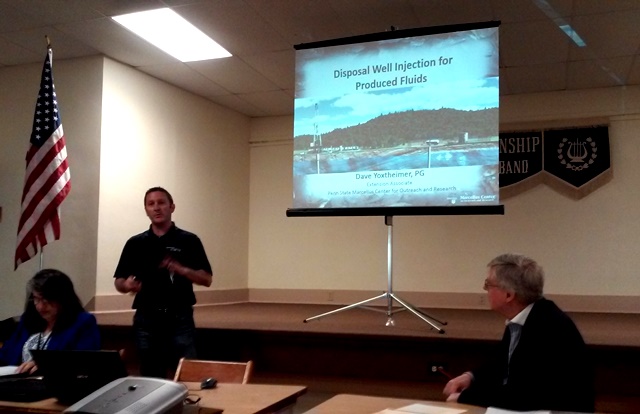
LUTHERSBURG – It has been a long, seven-year fight, but the residents of Highland Street Extension in Brady Township, have not given up on stopping a disposal injection well from being drilled nearby.
The fight’s been led by Darlene Marshall and her husband, the residents of not only that area, but also the City of DuBois, Sandy Township and Clearfield County. Additionally, evidence has been collected, letters written and meetings held.
The injection well is proposed to be a disposal site for wastewater from Marcellus Shale fracking. Residents fear that such a well will fail and contaminate the water table and their household water supplies. Highland Street Extension residents depend on well water to supply their homes.
However, after seven years, both the federal Environmental Protection Agency (EPA) and the state Department of Environmental Protection (DEP) have approved the well permit.
The Marshalls and their neighbors, the Atkinsons, have filed an appeal and Darlene Marshall explained during a public meeting held Thursday night at the Brady Township Community Center that the appeal could take as long as two years.
The Clearfield County Commissioners convened the meeting to update residents on what has happened, and to discuss options moving forward.
Commissioner Chairman John Sobel said that while they still hope that the well will be stopped, they need to be prepared if it should move forward. He said it is time to develop realistic and practical solutions to potential problems down the road.
He introduced David Yoxtheimer, P.G., a hydrologist, who works for Penn State Extension, Marcellus Center for Outreach and Research.
Yoxtheimer said he understood he was talking to an audience well educated in the ins and outs of disposal injection wells, but he wanted to go over some of the important points regarding such wells.
There are only a handful of these types of wells in Pennsylvania. Eight are active, five not online and two under review. He explained there are six categories of injections wells and this one would be a type II-D.
The purpose is to contain and disseminate fluid from hydraulic fracking, mostly brine already within the area being fracked, but also flow-back water from the fracking fluid.
He said Marcellus shale is rather dry and absorbs quite a bit of fluid. The rest is either recycled for fracking (85 percent), temporarily stored (9 percent) and the rest (6 percent) placed in injection wells.
He talked about construction, where different sizes of pipe are inserted into the ground and within each other at longer and longer lengths, sealed between each with concrete, until the final length reaches into a strata of sandstone, the Oriskany Sandstone formation.
Typically the company drilling the well needs to look at the location of private wells within at least one quarter of a mile radius, review seismic risk, detail how the well will be plugged and abandoned and also show financial responsibility.
Yoxtheimer said a study done in 1993 showed dismal results in reporting of mechanical integrity tests. Of 9,553 wells in four states, 10.5 percent failed the tests. He said regulation has improved since then.
He also talked about seismic activity and different ways human activity can cause earthquakes, including geothermal reservoirs, mining, damming impoundments, oil and gas operations and underground injection of fluids for waste disposal.
Penn State has installed a network of stations to monitor activity in the state and most incidents between 2013 and 2015 were caused either naturally or by mining activity.
An earthquake in Youngstown, Ohio, several years ago was due to the operator of the well operating at a higher rate of pressure than authorized.
Darlene Marshall also briefly spoke and said the appeal goes before the Environmental Hearing Board and it is a process requiring a lawyer.
Mary Ann Atkinson noted her water well is within 900 feet of the proposed injection well and other residents have wells even closer.
She asked residents not only of the area, but also across the county to contact their representatives and ask them to vote against House Bill 2154, which includes in the language an elimination of DEP oversight for injection wells. She added the federal Safe Water Drinking Act is for public water supply.
DuBois Councilwoman Diane Bernardo added that a damaged water supply adversely affects the growth of a community. She noted that the injection well is within the zone of endangerment for the DuBois reservoir.
She said it is crucial for the state to keep control in the situation and demand local state representatives do the right thing. She asked where they have been the last seven years. “We shouldn’t be trying to defeat a house bill,” she concluded.
County representatives briefly talked about options for public water. County Planning Director Jodi Brennan encouraged residents to get baseline water testing if they can and said the county is looking into funding to help residents be able to afford the testing.
Community Development Specialist Lisa Kovalick added that, should they reach a point where public water is needed, residents will need to fill out Low to Moderate Income surveys.
If it is determined 51 percent of the residents meet the guidelines, it will be easier to get money from Community Development Block Grants.
Brennan added there is also the possibility of Pennsylvania Infrastructure Investment Authority or U.S. Department of Agriculture funding.
Sobel ended the meeting by saying the county intends to continue working with citizens regarding the issue. “We’re here because we care,” he said.